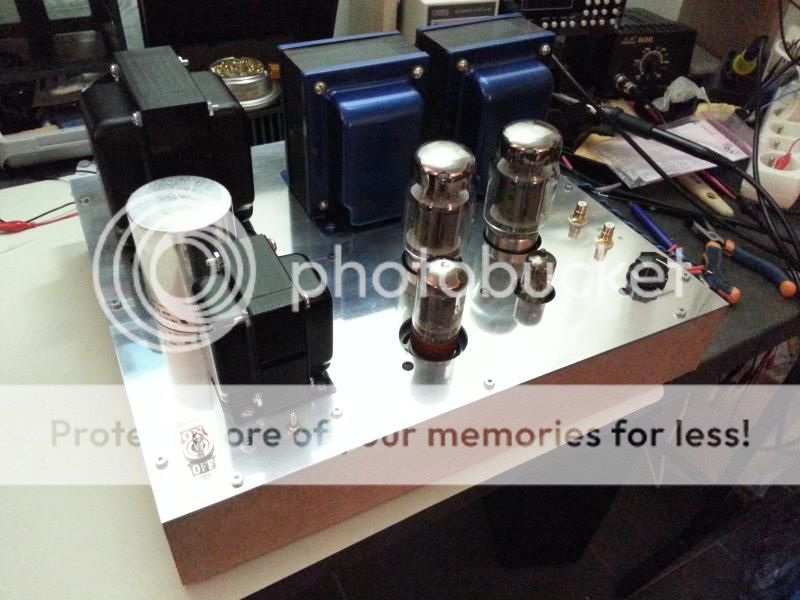Maybe increasing C2 value would help, either by changing my 120uf elco by something like a 220uf 500V or adding another 80uf motor cap to the one already installed.
I may also change the 47uf 500V C1 with a 33 or 39uf one as it should be more friendly for the rectifier.
The 120uF capacitor is fine for C2, it would'nt contribute to the hum. Of course you can use a higher value for C2 but
I doubt it will help to reduce hum.
Using a 33uF or 39uF 500V for C1 is a good idea as there will be less stress on the tube rectifier, especially the new production ones.
I see you have both tube and solid state rectifiers installed, did you try switching between the two ? Not with regards to the
hum problem but just to see how each perform.
Not yet, I'm a little cautious concerning solid state rectification as it seems new ixys production is more prone to blew up than the old ones, however I'll try for the sake of doing it 
As for the hum, what do you think about using a poly cap in // to the choke, as it seems to be a way to reduce power supply hum? If yes, witch value would be a good start?
As for a picture of the amp for transformers orientation, here it is:

As for the hum, what do you think about using a poly cap in // to the choke, as it seems to be a way to reduce power supply hum? If yes, witch value would be a good start?
As for a picture of the amp for transformers orientation, here it is:

Is your power trafo the one on the front left? If so, maybe try orienting it differently by rotating it 90 degrees.
I had a buzzing trafo, but got rid of the buzz by switching the wires on the choke (back left on mine). This shouldn't really matter, but the buzz has gone. It could also be that I soldered the choke and capacitor wires together where they both fasten to the PCB.
Either way, the buzzing Hammond has become a quiet Hammond (so far).
Anyway, these are simple things to try.
Charlie
I had a buzzing trafo, but got rid of the buzz by switching the wires on the choke (back left on mine). This shouldn't really matter, but the buzz has gone. It could also be that I soldered the choke and capacitor wires together where they both fasten to the PCB.
Either way, the buzzing Hammond has become a quiet Hammond (so far).
Anyway, these are simple things to try.
Charlie
Charlie (what a fine name.....we are all Charlie  :
:
No it's the choke, the power trafo is the big black one next to the two blue edcor Ots. The PT is already oriented at 90° from the Ots and altering the choke orientation has not proved any benefits.
Switching choke wires? Interesting, I thought chokes where non polar .... anyway I'l try swapping the wires to see if it makes any diference.
I'm also thinking about soldering wires directly on the pcb, hence getting rid of the terminal posts, don't know if I may find a benefit soundwise by doing this but it's clearly a cleaner way of interconnecting things (even if it means far less practical)
No it's the choke, the power trafo is the big black one next to the two blue edcor Ots. The PT is already oriented at 90° from the Ots and altering the choke orientation has not proved any benefits.
Switching choke wires? Interesting, I thought chokes where non polar .... anyway I'l try swapping the wires to see if it makes any diference.
I'm also thinking about soldering wires directly on the pcb, hence getting rid of the terminal posts, don't know if I may find a benefit soundwise by doing this but it's clearly a cleaner way of interconnecting things (even if it means far less practical)
Cowneko,
Funny....
I know that the choke wiring shouldn't matter, but when I swapped the wires, the buzzing Hammond stopped buzzing. Could be better coupling of the choke and cap wires in the terminal block, but most importantly, the buzz has gone.
It'll be interesting to see if it returns when I try my kt120's, which draw more heater current.
Charlie
Funny....
I know that the choke wiring shouldn't matter, but when I swapped the wires, the buzzing Hammond stopped buzzing. Could be better coupling of the choke and cap wires in the terminal block, but most importantly, the buzz has gone.
It'll be interesting to see if it returns when I try my kt120's, which draw more heater current.
Charlie
Most builders including myself have used a choke only and haven't had any problems. I don't know if adding a capacitor in parallel with
the choke will be helpful. My technical skills are probably on the same level as yours so I regret I'm unable to advise on this aspect.
Your transformers and choke orientation is okay. I have a similar orientation on mine except the location of my power xfrmr and choke
are reversed, that is, my power xfrmr is located at the front. I did this mainly to distribute some of the weight to the front of the chassis.
The screw terminals for wiring up the board is to make life easier, especially for beginners who may have to troubleshoot problems.
After the amp is working well for a good while, anyone who wish to do so can remove the terminals and solder the wires directly to
the board. I have no problem with the terminals, I am pleased with the sound as it is.
When you get your new cathode resistors we'll see if they result in any improvement.
- Status
- This old topic is closed. If you want to reopen this topic, contact a moderator using the "Report Post" button.